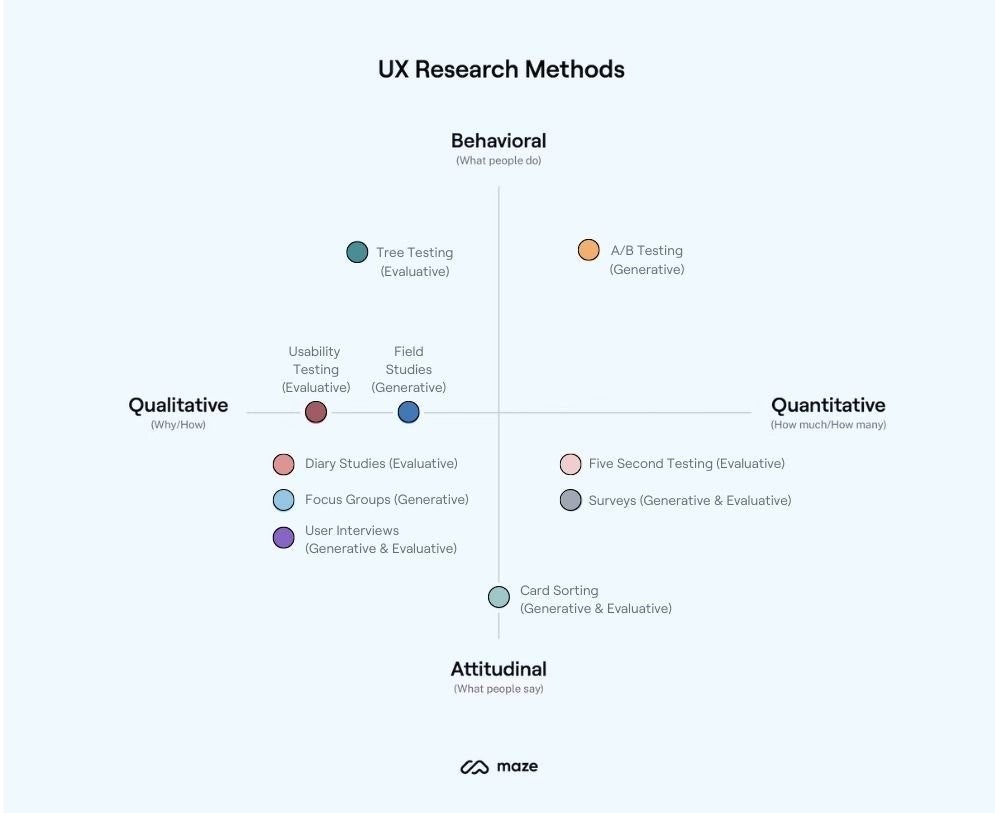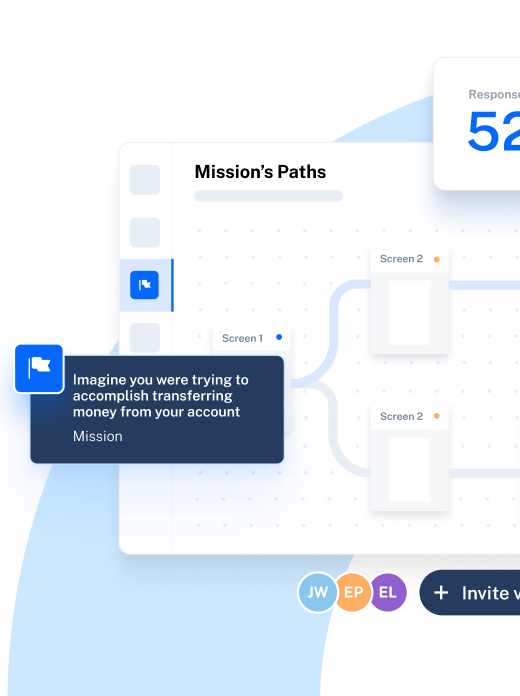If you ask most folks around a business whether they think UX research is important, the majority will say yes. But believing in the value of research, and investing in it are two different things—with different roadblocks to overcome.
While organizations know you should invest in research, securing budget and getting buy-in is another story.
And with 55% of product teams saying the demand for user research has increased in the past 12 months, the time for sitting on the fence is over.
In this article, we lay out why all businesses need to invest in UX research; how it impacts business growth, product success, and user satisfactionand—and how to make a case for it within your company.
Why is UX research important?
UX research is how you get inside your user’s mind. It helps you build user-centric designs that meet actual user needs. It’s how you replace intuition with insights to save time, money, and effort when pursuing your business goals.
Not to mention, UX research is important because it’s a business multiplier.
In fact, a single UX change informed by research can be business-changing. Just look at the $300 million button story—where UX insights and a subsequent UX change ended up boosting conversions by 45%, generating $15 million in one month (Jared Spool: The $300 Million Button).
Forrester's report also shows that products and websites with a “superior” user experience see 400% higher visit-to-lead conversion rates (Forrester: The Six Steps for Justifying Better UX).
Plus, our Future of User Research Report 2025 found that organizations that integrate UX research into decision-making see:
- ✅ 3.6x more active users
- ✅ 5x stronger brand perception
- ✅ 2.7x better business outcomes
- ✅ 34% higher customer retention
- ✅ 3.2x improved product-market fit
So the reasoning is simple: more research leads to greater impact. Businesses that embed UX research into their design and decision-making processes create better user experiences, increase customer satisfaction, and drive long-term growth.
What types of businesses should invest in UX research?
Unsurprisingly, the answer is all businesses should invest in UX research.
UX research unlocks value for all businesses, regardless of scale, product, or customer. Whether you're a product manager, UX researcher, or design leader, user research is how you identify what users want, and ensure you design and deploy the right features, rather than wasting time and money on the wrong ones.
Still on the fence? Here's how research can help...
Mid-market and enterprise companies in tech and finance
Companies operating in complex, regulated, or high-growth sectors—like technology and finance—have the most to gain from structured UX research. In these environments, understanding user behavior can help you reduce risk, inform product direction, and stay competitive. UX research helps teams validate ideas earlier, avoid costly reworking, and make confident, data-driven decisions.
Organizations where researchers control the budget
In many organizations, researchers or research operations professionals are the primary budget holders for UX tools and initiatives. When these teams lead purchasing decisions, they need tools that deliver fast, repeatable insights and clearly tie research to product outcomes. Investing in UX research supports faster cycles, greater influence across departments, and stronger internal alignment.
Companies transitioning from legacy research tools
Organizations switching from legacy platforms—such as UserTesting or UserZoom—are often looking for more agility, lower complexity, and better value. UX research becomes a strategic investment in this transition, helping teams modernize their processes, reduce inefficiencies, and run more frequent studies without compromising quality.
Teams aiming to scale research beyond the research team
As research teams face layoffs, headcount caps, or increasing demand, many organizations are moving toward democratizing research across functions. In these cases, UX research must be accessible to non-researchers—like designers, product managers, or marketers—who can run tests independently while maintaining research quality. This helps scale insights without bottlenecks and protects against knowledge loss or team disruption.
It doesn’t need to start big, but it needs to start. No matter the size of your business, if you’re not running UX research then you’re missing out on valuable user insights that can help improve decision-making across your organization.
Why all businesses should invest in UX research: Save time, money, and effort
Insights trump intuition, every single time.
UX research saves you time, money, and effort by giving you insights into what users really want, instead of relying on guesswork. Intuition and ideas are valuable assets to a product team, but they only get you so far. You need data-backed insights to ensure you’re making informed decisions every time.
Investing in UX research can be a big step for businesses, but it’s well worth it. Here are six reasons to prioritize investing in UX research.
1. Investing in UX research reduces wasted time and development costs
There’s no denying that the biggest reason for investing in UX research is just how much time and money it can save you. It’s simple:
UX research → understanding what users want → building what users want → user engagement → profit
Versus…
No UX research → not understanding what users want → building what you think users want (or, worse, what you want to build) → lack of users → no profit (or, worse, loss)
When you conduct user research upfront, you’re able to validate or reject ideas and designs before spending time, effort, and money developing them. UX research asks users what they want instead of presuming what they want, saving you valuable resources. Investing early on avoids developing and deploying designs that simply don’t meet user needs.
Depending on the size of your organization and product functionality, building the wrong thing can cost anywhere from several thousand dollars, to several million. Not only is this wasted money, but it’s a huge amount of wasted time that could have been invested building something your users actually need.
Without investing in UX research, at least 50% of your development team’s time is spent doing entirely avoidable reworks. Your developers—whether in-house or external—are expensive, and their time is incredibly valuable. MMoving un-tested designs into development will cost you more in post-production than if you invest in UX research to build the right thing the first time around.
💡 Curious about how much you could save with UX research?
This free online Product Waste Calculator shows how much money your organization may be throwing away on the wrong products.
2. Investing in UX research creates and retains loyal customers
Another benefit of investing in UX research is that it’s crucial for creating (and keeping!) loyal customers. Why? Two reasons:
- UX research indicates to users that you care about their wants, needs, and pains
- UX research enables you to continually deliver on those wants, needs, and pains
The result? Users get the products they expect, while feeling they’re involved in the process, and valued by you—improving the customer experience, increasing customer satisfaction and NPS scores.
Let’s say you send out a customer feedback survey, and users repeatedly highlight a new feature they’d like. Not only does this investment in UX research help inform your UX roadmap, but it ultimately helps you create a more user-centered product and increase customer loyalty.
By making decisions and developing features off the back of feedback, you show users they’re valued and listened to, cultivating positive user <> product relationships and nurturing loyalty.
3. Investing in UX research attracts and converts new customers
88% of consumers trust recommendations from people they know above all other forms of marketing. So in a world of AI-generated news and marketing, human-to-human recommendations are gold dust for reaching new users.
UX research boosts user loyalty, and within your loyal customer base are trusted brand advocates.
If you’re investing in UX research and acting on user insights, your existing users will be more likely to recommend your product or services to others. This increases organic customer acquisition and reduces the amount you spend on costly acquisition campaigns.
But, that’s not all—UX research also enables you to investigate and optimize the customer journey, from awareness to conversion. By running surveys, interviews, and usability tests, you can identify what works—and what doesn’t—when attracting and converting new customers.
Your existing customers were all once prospects, meaning they have unique insights into what motivated their conversion to paying customers—and what doubts they had along the way. Use these customer insights to improve the customer journey for future customers.
4. Investing in UX research builds better products and customer experiences
Okay, this one feels somewhat obvious, but we can’t go without mentioning it: the undebatable truth of UX research and design is that it’s the **key to building better products, and—by extension—better customer experiences**.
User research unlocks value in many ways, from guiding overarching strategic direction and product discovery to delving into the nitty-gritty with specific usability issues.
The many UX research methods that are available to you and your team make uncovering decision-driving insights easy at all stages of the design and product development process. Whether you have a specific focus or are just looking for insights to help guide your decisions, there’s a UX research method to help you.
Just a few ways different methods can help are:
- Product discovery identifies if new features or products could benefit your users
- Concept testing validates ideas with real users before you begin building
- User interviews provides first-hand insights from users and digs into sentiment
- Prototype testing helps assess functionality and confirm your designs are on track
- Card sorting uncovers the way your users think about and understand content
- Tree testing reveals the ideal way to structure your information architecture
- Usability testing reviews usability before and after launch to ensure smooth UX
- UX surveys quickly gather insights and feedback in a versatile technique

Of course, this is just an example. UX research methods are versatile, and can be applied at many stages of the UX design process. There’s no rulebook for using UX research methods throughout the product development process—they’re tools to provide guidance and direction as and when you need them.
5. Investing in UX research enables better decision-making across the organization
UX research doesn’t only impact your customers and your research team—it benefits your wider organization too, by creating a user-centered culture and generating atomic research nuggets you can store in your research repository and use across the team. For example, insights uncovered during user research can help:
- The marketing team, to adjust their messaging to highlight features that existing customers note as crucial in their decision to convert
- The sales team, to engage differently with prospects depending on the features and functionalities identified for their use case and pain points
- The support team, to improve how they handle issues, and create documentation on common problems and queries
While UX research and design is a strong asset for crafting wonderful online experiences for our clients, it is also a strong asset to help optimize internal processes and tools.
Geoffrey Crofte
Senior UX Lead at Groupe Foyer
Share
Insights collected from user research can inform and optimize your day-to-day decision-making, but they also have the potential to shape your entire growth strategy. UX research can guide you toward the best way forward—whether it’s something as simple as updating a button, or as impactful as navigating uncertainty in your business and industry.
✨ Need more reason to invest in UX research? Check out our up-to-date selection of 30+ UX statistics on the state of UX in 2025.
6. Investing in UX research keeps you competitive
Last, but by no means least, UX research keeps you engaged in competitive product analysis to monitor the competition and benchmark your product.
Investing in UX research also ensures you’ve got your finger on the pulse of UX research trends and what customers want next. By continuously talking to users and understanding their needs, you’ll find that you uncover opportunities for innovation that competitors haven’t yet identified.
For example, consider AI. It’s making its way into every industry—and for good reason. AI can automate and optimize tasks in ways that were previously impossible. But how to apply AI to your own products isn’t always obvious. With thousands of applications, knowing where to focus your efforts is crucial for gaining a competitive advantage over others in your industry.
Conducting UX research—like interviewing users and running feedback surveys—helps you identify the ways that you can harness the power of AI in UX design. Of course, user feedback doesn’t tell you exactly what to do—but with real user insights and your team’s knowledge, you’re more likely to build the solutions people need before anybody else does.
💡 Hear from your users with Maze AI.
Optimize your surveys with the Perfect Question, effortlessly add Dynamic Follow-Up questions to dig deeper, and get high-level trends to uncover insights faster.
UX research puts your users at the heart of product decision-making. If you don’t build products, features, and experiences that customers actually want, they’ll leave. Maybe not today, and maybe not tomorrow—but when they see that your competitors care more about their experience than you do, they’ll jump ship.
Start small, and let UX research guide you to bigger things
The benefits of UX research can’t be overstated. It takes the guesswork out of building a product and experience that users love, and gets your customers involved in your development and growth, making them more invested in your success.
Getting started can be simple, too. You don’t need a ten-person team or all the UX books and knowledge in the world—you just need the desire to build with a user-centric mindset, and a UX research tool.
Maze’s suite of UX research tools facilitates all types of user research, and automated, visual-rich reports make sharing your findings fast and useful for the whole team. With AI-powered insights and integrations with leading design and prototyping tools, teams can collaborate easily and build products users love.
Frequently asked questions about investing in UX research
Is it worth investing in UX research in 2025?
Is it worth investing in UX research in 2025?
Absolutely yes, it’s worth investing in UX research in 2025. Companies that invest in UX research see better retention, decision-making, and ROI. With AI research tools making research faster and more accessible, teams can prioritize user needs, reduce costly rework, and improve customer satisfaction—all while staying ahead of competitors.
Why is UX research important?
Why is UX research important?
UX research is how you create products and experiences that your users love. Without user insights, you’re making crucial decisions based on guesswork. UX research helps save on development costs, increase customer retention and acquisition, remain competitive, and guide decision-making.
What’s the ROI of UX research and design?
What’s the ROI of UX research and design?
Forrester previously reported that every $1 invested in UX yields a return of $100. That’s a return on investment of 9,900%. Although this study is old, it gives you an idea of the ROI of UX.






